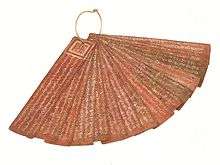Lōmāfānu

Isdhoo Lōmāfānu is the oldest copper-plate book to have been discovered in the Maldives to date. The book was written in AD 1194 (590 AH) in the Evēla form of the Divehi akuru, during the reign of Siri Fennaadheettha Mahaa Radun (Dhinei Kalaminja).
Lōmāfānu (or loamanfaanu) are Maldivian texts in the form of copper plates on which inscriptions have been added. Many new Maldivian historical texts are found only in lōmāfānu form, with the oldest of the plates dating from the twelfth century AD. The Divehi beys script used on the plates was named "eveyla balhu" by H. C. P. Bell, who claimed that it resembled medieval Sinhala script.
According to the Isdū Lōmāfānu, monks from monasteries of the southern atoll of Haddhunmathi were brought to Malé and beheaded. Besides the lōmāfānu plates found in Haddhunmathi Atoll, one of the most important Maldivian copper plates is the Bodugalu Miskiy Lōmāfānu found in Malé.
See also
References
- Ali Najeeb, Dambidū Lōmāfānu. Council for Linguistic and Historical Research. Malé 2001.
- HCP Bell, The Maldive islands. Monograph on the History, Archaeology and Epigraphy. Reprint 1940 edn. Malé 1986.
- Bodufenvahuge Sidi. Divehi Akuru; Evvana Bai. Malé 1958.
- H.A. Maniku & G.D. Wijayawardhana, Isdhoo Loamaafaanu, Colombo 1986.
- Romero-Frias, Xavier. The Maldive Islanders, A Study of the Popular Culture of an Ancient Ocean Kingdom. Barcelona 1999.
hibban
This article is issued from
Wikipedia.
The text is licensed under Creative Commons - Attribution - Sharealike.
Additional terms may apply for the media files.